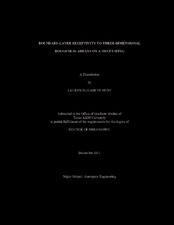| dc.contributor.advisor | Saric, William S. | |
| dc.creator | Hunt, Lauren Elizabeth | |
| dc.date.accessioned | 2012-02-14T22:19:38Z | |
| dc.date.accessioned | 2012-02-16T16:16:16Z | |
| dc.date.available | 2012-02-14T22:19:38Z | |
| dc.date.available | 2012-02-16T16:16:16Z | |
| dc.date.created | 2011-12 | |
| dc.date.issued | 2012-02-14 | |
| dc.date.submitted | December 2011 | |
| dc.identifier.uri | https://hdl.handle.net/1969.1/ETD-TAMU-2011-12-10351 | |
| dc.description.abstract | On-going efforts to reduce aircraft drag through transition delay focus on understanding the process of boundary-layer transition from a physics-based perspective. For swept-wings subject to transition dominated by a stationary crossflow instability, one of the remaining challenges is understanding how freestream disturbances and surface features such as surface roughness create the initial amplitudes for unstable waves. These waves grow, modify the mean flow and create conditions for secondary instabilities to occur, which in turn ultimately lead to transition. Computational methods that model the primary and secondary instability growth can accurately model disturbance evolution as long as appropriate initial conditions are supplied. Additionally, transition delay using discrete roughness arrays that exploit known sensitivities to surface roughness has been demonstrated in flight and wind tunnel testing; however, inconsistencies in performance from the two test platforms indicate further testing is required. This study uses detailed hotwire boundary-layer velocity scans to quantify the relationship between roughness height and initial disturbance amplitude. Naphthalene flow visualization provides insight into how transition changes as a result of roughness height and spacing.
Micron-sized, circular roughness elements were applied near the leading edge of the ASU(67)-0315 model installed at an angle of attack of -2.9 degrees in the Klebanoff-Saric Wind Tunnel. Extensive flow quality measurements show turbulence intensities less than 0.02% over the speed range of interest. A survey of multiple roughness heights for the most unstable and control wavelengths and Reynolds numbers of 2.4 x 10⁶ 2.8 x 10⁶ and 3.2 x 10⁶ was completed for chord locations of 10%, 15% and 20%. When care was taken to measure in the region of linear stability, it was found that the disturbance amplitude varies almost linearly with roughness height. Naphthalene flow visualization indicates that moderate changes in already-low freestream turbulence levels can have a significant impact on transition behavior. | en |
| dc.format.mimetype | application/pdf | |
| dc.language.iso | en_US | |
| dc.subject | crossflow | en |
| dc.subject | boundary-layer transition | en |
| dc.title | Boundary-Layer Receptivity to Three-Dimensional Roughness Arrays on a Swept-Wing | en |
| dc.type | Thesis | en |
| thesis.degree.department | Aerospace Engineering | en |
| thesis.degree.discipline | Aerospace Engineering | en |
| thesis.degree.grantor | Texas A&M University | en |
| thesis.degree.name | Doctor of Philosophy | en |
| thesis.degree.level | Doctoral | en |
| dc.contributor.committeeMember | Bowersox, Rodney | |
| dc.contributor.committeeMember | Reddy, JN | |
| dc.contributor.committeeMember | Reed, Helen | |
| dc.type.genre | thesis | en |
| dc.type.material | text | en |


